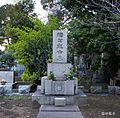Ryukichi Inada
Ryukichi Inada | |
|---|---|
Đạo điền long cát | |
 | |
| Born | March 18, 1874 Nagoya,Japan |
| Died | February 27, 1950(aged 75) |
| Alma mater | Tokyo Imperial University |
| Awards | Order of Culture |
| Scientific career | |
| Fields | Bacteriology |
| Institutions |
|

(Kyushu University)

Ryukichi Inada(Đạo điền long cát,Inada Ryūkichi,March 18, 1874 – February 27, 1950)was a Japanesephysician,prominentacademic,andbacteriologistresearcher. He discovered theWeil's diseasepathogen. In addition to his life's work in early 20th-century Japanese medical education, he was a pioneer in Japanese clinicalcardiologyandoncology.
Early life
[edit]Inada was born inNagoyaand graduated fromTokyo Imperial Universityin medicine before travelling abroad for medical studies inGermany.
Career
[edit]Returning to Japan from Europe, Inada became the first professor of medicine at Fukuoka Medical College(Phúc cương y khoa đại học,Fukuoka Ika Daigaku)of the Kyoto Imperial University(Kinh đô đế quốc đại học,Kyōto Teikoku Daigaku),nowKyushu University,School of Medicine.
In 1914–1915, Inada discovered thespirochetebacteria that causes infectious jaundice (Weil's disease) and developed a successfulantiserumtreatment for the infection.[1]He is credited with ground-breaking research on the Weil's disease pathogen,Leptospira.The initial specimen material (stock of Ictero No.1) which Dr. Inada isolated in 1914 has been preserved as a significant artifact in the history of medicine. In 1915, Inaba described the pathogen in a series of papers titled "Hemorrhagic Icterus 'Spirochaete' Disease"(Nhật bổn hoàng đản xuất huyết tính “スピロヘータ” bệnh,Nihon ōdan shukketsu-sei supirohēta byō)covering content ranging from the discovery of the pathogen, to contagion sources, clinical medicine, pathology, diagnosis, and cure.
Professor Inada was the first in Japan to import an electrocardiograph and, along with medical school colleagues, was amongst the first to use this device clinically in Japan.[2]He was a prominent Japaneseoncologistas well, serving as Vice President of the Japanese Society of Oncological Research from 1919 until his death in 1950.[3]
In 1920 he was installed as professor of medicine at the medical school of Tokyo University(Tōkyō daigaku igakubu).In 1928, he reported the first cases ofulcerative colitisin Japan, ten cases collated over ten years.[4]In 1943, he was named the President of theJapanese Medical Associationand the President of the Japan Medical Treatment Corporation. In 1919, Inada and his co-worker Yutaka Ido were nominated by Louis Martin of Pasteur Institute, Paris for theNobel prizein medicine for their 1915 discovery.
Honors
[edit]He was awarded theOrder of Culture(Văn hóa huân chương,Bunka kunshō).
TheMaidashicampus ofKyushu Universityhas commemorated Dr. Inada's contributions to the institution by naming one of the campus streetsInada dōri.
Citations
[edit]- ^Garrison, Fielding Hudson. (1921).An Introduction to the History of Medicine,pp. 767-768.
- ^Kyushu University Hospital, history.
- ^Aoki, Kunio.Contributions to Cancer Prevention of Non-Governmental Organizations,Archived2008-05-16 at theWayback MachineAsian Pacific Journal of Cancer Prevention,Vol 2. (2001), p. 21.
- ^Matsuoka, Katsuyoshi."73rd Annual Meeting of the Medical Society of Toho University Professor Special Lecture The History of Ulcerative Colitis Revealed by the Literature"(PDF).Toho Journal of Medicine.6(2). The Medical Society of Toho University: 57.ISSN2189-1990.
References
[edit]- Kobayashi, Y."Discovery of the causative organism of Weil's disease: historical view,"Journal of Infectious Chemotherapy.Vol. 7, No. 1, pp. 10–15 (2001 March).
Gallery
[edit]-
Inada dōri
-
KyushuImperial University internal medicine laboratory
-
grave



